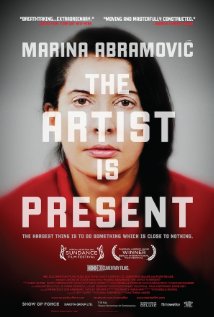
The Artist Is Present: Marina Abramovic has finally arrived in the US and is being shown in a pair of theatres—one in New York and the other in Los Angeles. Producer Jeff Dupre approached the seminal performance artist with the idea of documenting what would become her legendary three-month-long performance of the same title at MOMA in 2011.
The action in the film takes place in the six moths leading up to the March 2011 opening of the New York’s Museum of Modern Art (MOMA)’s retrospective of the artist’s work and first major exhibition at an institution of this level dedicated to performance art. The film, in a seamless interweaving of past and present revisits historical documentation of Abramovic’s original performances and the preparations to re-create them with contemporary young performers. It soon becomes clear that the “retrospective” aspect of the exhibition soon takes a back seat to her ground-breaking new work, The Artist is Present, in which Abramovic would remain seated on a wooden chair in the center of the second floor pavilion of MOMA all day, every day while the museum was open during the length of the exhibition. Visitors were encouraged to take an identical chair directly across from the seated artist and, for as long as they wished engage in a silent, unphysical encounter. No restrictions were placed on the duration of a visitor’s stay with Abramovic, the rules were simply that they not touch or speak to her or otherwise cause a disruption. One aficionado visited Abramovic a total of twenty-one times, the longest visit lasted 7 hours (in the film he proudly displayed a new tattoo that commemorates the number of his encounters). As with much of the artist’s ouvre, the performance acted as a mirror to reflect the actions, personalities and potentialities of the audience and society at large. The guard’s censorship of the few visitors who attempted to break the rules, the way in which the exhibition itself began to resemble the media frenzy of a rock concert all were unplanned, but intrinsic elements of the work. Abramovic’s physical endurance and concentration, technical skill at its zenith are inseparable from a complete vulnerability and reliance on the audience as a whole to create the work.
In addition to revealing the complex and poetic forces behind the work itself, the film’s sub-plot, that of Abramovic’s relationship with her long-time partner and collaborator in her personal and professional lives Ulay is equally as gripping. Director Matthew Akers accurately describes their’s as one of the greatest love stories ever—and it truly is—a often un-discussed gem in Abramovic’s practice.
My allowing us to re-live the performative event of last year while contextualizing it and placing it in a narrative and context that would have been unrealized when visiting the actual exhibition, the film contributes to an additional dialogue around the nature of performance art itself. Abramovic admitted that she only saw the film in its entirely once—each additional viewing encroached an often times overly painful reliving of the long hours seated nearly motionless. Indicative of the power of performance to live on past its original life, the film further cement Abramovic’s status as a legendary artist even as it subverts the foundation upon which her work is built. Watching the film, the artist is not literally present, yet her presence transcends such physical and temporal boundaries.

Marina is so annoying